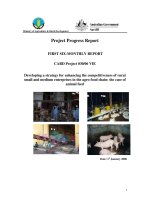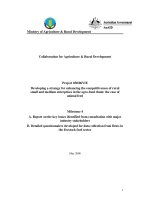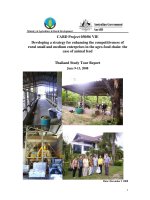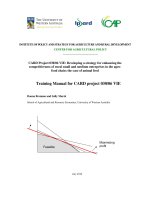Analyzing determinants of profit of small and medium enterprises in the Mekong Delta
Bạn đang xem bản rút gọn của tài liệu. Xem và tải ngay bản đầy đủ của tài liệu tại đây (505.75 KB, 7 trang )
ECONOMIC DEVELOPMENT
No. 204, August 2011
ANALYZING DETERMINANTS OF PROFIT OF
SMALL AND MEDIUM ENTERPRISES IN THE MEKONG DELTA
by Assoc. Prof., Dr. LEÂ KHÖÔNG NINH*
This paper aims at getting an insight into determinants of return of small and
medium enterprises (SMEs) in the Mekong Delta through the estimation of the
regression model in which return on sales (ROS), or operating profit margin, is a
dependent variable, and determinants of their profit are independent variables. The
estimation is based on primary data gathered from 1,017 enterprises in the period
2006 - 2010. The results reveal that their ROS is affected by (1) ratio of fixed assets to
sales, (2) sizes of the enterprises, (3) the ratio of current assets to sales, (4) and (5) the
age and origin of machinery, and (6) the GDP growth rate. The paper, thereby,
proposes measures to raise SMEs’ returns.
Keywords: profit, sales, small and medium enterprises, economic growth
1. Introduction
Profit is one of the primary goals of a
business. It is vital for the development of not
only the business itself and industry but also the
whole economy. Especially for SMEs, profit is
even more important because it allows them to
expand their scales and modernize their
technology for a future sustainable growth.
Practical experiences, along with previous
studies, show that an enterprise’s profit is
influenced by both microeconomic factors
belonging to the enterprise itself (capital,
managing capabilities, and scales, etc.) and
macroeconomic factors (economic growth rate,
interest rates, inflation, performance of
governmental bodies). However, effects of these
factors are not always the same, that is, some of
them make impacts in certain situations and at
certain times while the others do not, and vice
versa. Hence, it is of necessity to fathom the
factors to improve businesses’ profit, thereby
promoting economic growth, as businesses are
producers of goods, a primary component of the
gross output of a province, region or country.
The paper aims at analyzing determinants of
profit among SMEs in the Mekong Delta and
*Caàn Thô University
thereby putting forward solutions to development
of this class of enterprises. This is very
meaningful because SMEs have been taking a
considerable part in increasing income, providing
employment and promoting economic growth.
The estimation is conducted through a regression
model that is comprised of determinants of profit
and based on primary data gathered from 1,017
enterprises in the period 2006 - 2010 in
combination with secondary data from related
agencies.
2. Methodology and model
As mentioned above, the paper is to estimate
the regression model, in which return on sales
(ROS), or operating profit margin, is the
dependent variable, and determinants of their
profit are independent variables as indicated in
previous researches and practices. Here is the
model:
RESEARCHES & DISCUSSIONS
27
ECONOMIC DEVELOPMENT
No. 204, August 2011
TYSUATLN 0 1CHUYENMON 2TSCODINH however, the upward trend will continue after
the size reaches a second marker. Thereby, profit
3QUYMO 4QUYMO 2 5QUYMO3
margin is the cubed function of sizes (as shown in
6TSLUUDONG 7 HQNHANUOC
the model), in which the coefficient 3 of the
CPBOITRON CPBOITRON 2
8
9
10TUOIMAYMOC 11NGUONGOCMM
variable QUYMO (the logarithm of fixed assets
4 negative and 5 positive.
12TAPHUAN 13CANHTRANH
value) is positive,
14MATBANG 15TTRUONGGDP
As the survey covers only SMEs, however, the
above-mentioned advantages of large businesses
are absent. It is just that when sizes expand,
profit margin will rise because of decreases in
average and marginal costs. As for SMEs, they
usually do not follow modern management
models and lack professional managers, and they
fail to adjust management models and
capabilities just in time when their sizes go
beyond a certain marker with the result that
their expenses tend to increase and profit
16 LAISUAT 17 LAMPHAT
In the model, TYSUATLN (%) is operating
profit margin. CHUYENMON is the manager’s
expertise determined by his/her educational
background. Researches have shown that the
more professional managers are, the more they
can approach new knowledge of management
and
technologies,
resulting
in
higher
effectiveness in deploying resources to increase
profit. Therefore, the coefficient 1 is expected to
be positive.
TSCODINH is the ratio of fixed assets to
sales. The higher the ratio is, the less effectively
the potential of fixed assets are exploited, which
decreases profit (Demir, 2009). Therefore, the
coefficient
2 is expected to be negative.
The profit of a business is closely connected
with its size (Porter, 1998; Amato and Amato,
2004). According to Porter (1998), large and
small enterprises have advantages to grow fast
over medium ones. Specifically, small businesses
can easily exploit market niches at low costs to
increase profit, thanks to their inherent
flexibility. And despite their poorer flexibility,
large businesses have strategies to dominate the
market to gain higher profits by means of their
prestigious brand names and economies of scale.
Meanwhile, enterprises of medium size not only
lose flexibility but also fail to develop these
strategies because their prestige and size are not
big enough.
Altogether, the operating profit margin of a
business will rise steadily when its size reaches a
certain marker, and it will fall afterward;
28
RESEARCHES & DISCUSSIONS
decreases. The coefficient
positive and
3 will then be
4 negative.
Another crucial determinant of a business’s
profit is current assets (cash, money reserves,
etc.). They help businesses make the best use of
productive opportunities by allowing them to
employ more workers, increase reserves for
higher product supplies, boost advertising, and
open more showrooms or customer care centers,
etc. In addition, if current assets are sufficient
and used effectively, they can keep enterprises
from taking out short-term loans and therefore
from the adverse effects of fluctuations in interest
rates. As a result, the research also includes the
variable TSLUUDONG (the ratio of current
assets to sales). The coefficient
6 is expected to
be positive.
HQNHANUOC is a dummy variable
measuring the performance of commercial
authorities such as Services of Planning and
Investment, Services of Trade and Industry and
Tax Agencies, etc. The measurement is based on
the feedback by the enterprises surveyed. The
variable alternately takes the values of 1, 2, 3
ECONOMIC DEVELOPMENT
No. 204, August 2011
and 4 which correspond to ineffectiveness, low
effectiveness, effectiveness, high effectiveness. It
is obvious that if public services succeed in
assisting businesses
to fulfill necessary
procedures in less time and cost to take
productive opportunities, then profit will rise. As
One of the determinants of a business’s profit
is the age of machinery (TUOIMAYMOC). Old
machinery can diminish profitability because
they raise costs of operation and maintenance
and reduce output quality and productivity. Thus,
7 is expected to
Besides,
the
origin
of
machines
(NGUONGOCMM) also affects businesses’ profit.
The dummy variable is given the value of 0 if
machinery is made locally and 1 if imported. It
affects profit margin in two opposing ways. On
the one hand, foreign machinery is more modern
and more efficient, thus increasing profit. On the
other hand, the purchasing price of these
machines is higher, resulting in higher
amortization cost and lower profit. Consequently,
a consequence, the coefficient
be positive.
The research also covers the effects of
“greasing-the-wheels” expense. Economists have
formed various arguments about relationship
between “greasing” expense and profit. The
positive view has it that “greasing” expense can
increase businesses’ profit because it makes
administrative machinery run smoothly thereby
helping enterprises take profitable opportunities
timely (Svensson, 2005). The negative view,
however, maintains that such expense increases
the production cost and reduces the profit.
Moreover, once enterprises accept to pay
“greasing” expense, corrupted officials will
produce more red tapes to milk more “grease”
from enterprises (Krueger, 1993), which can take
profitable opportunities away from enterprises.
Through empirical studies, economists have
pointed out that a non-linear relationship
between “greasing” expense and a business’s
profit did exist. This means that those
enterprises which are willing to grease corrupted
officials’
hands
will
exploit
profitable
opportunities better. The assumption is true in
reality where many enterprises proactively pay
“greasing” expense before being asked because
they think that this will facilitate their business.
However, if the expense rises too much, it will
lower profit. Thus, “greasing” can help increase
enterprises’ profit to a certain extent and when
the expense goes up substantially, it will reduce
profit. As a result, the coefficient 8 of the
variable CPBOITRON (the ratio of “greasing”
expense to fixed assets) is positive and
negative.
9
10 is expected to be negative.
11 can be positive or negative depending on
whichever factor dominates.
What also contributes to an enterprise’s profit
is the number of training courses taken by
business managers (TAPHUAN). Attending these
classes can help managers enhance managing
capabilities, build good relations with customers
and suppliers, and keep their knowledge updated,
etc. Hence,
12 is usually expected to be positive.
Nonetheless, some studies have indicated that
the influences of the variable on profit depend on
the quality of the classes as well; that is, classes
of good quality will have positive effects on profit,
and vice versa.
According to the microeconomic theory,
competition is also an influential factor to profit.
The more intense the competitive pressure
becomes, the harder enterprises have to try to
improve the quality of their products, to
strengthen advertising and sales promotion, etc.
to avoid a loss of market shares. Yet, these
activities can be beneficial in the long term, but
will raise expenses and reduce profit in the short
term. Therefore, the coefficient
13 of the
variable CANHTRANH (representing competi-
RESEARCHES & DISCUSSIONS
29
ECONOMIC DEVELOPMENT
No. 204, August 2011
tion) equals 1 if the competitive pressure facing
enterprises is low, 2 if moderate, 3 if high, or 4 if
very high. And it is expected to be negative.
To make full use of opportunities to increase
profit, enterprises need good premises for
displaying products, opening offices, etc. Thus,
the lack of premises can diminish such
opportunities. The coefficient
14 of the variable
MATBANG (representing premises) takes the
value of 1 if the premises are insufficient for
doing business and manufacturing, 2 if they are
barely sufficient for current use, 3 if they are
sufficient for the next one to five years, and 4 if
they will be available in the long term. The
coefficient is expected to be positive.
Aside from microeconomic factors, profit is
also influenced by macroeconomic ones,
particularly
the
GDP
growth
rate
(TTRUONGGDP). It is because if the economy is
booming, all sectors will function well and
people’s income and spending will rise, therefore
facilitating business operations. In contrast, if
the economy stagnates, banks will limit their
loans, so enterprises will be underfunded and
consumption will fall, resulting in decreased
business profit. In consequence, the coefficient
15 of TTRUONGGDP is expected to be positive.
There are two other variables which affect
profit, LAISUAT (formal lending rates, %/year)
and LAMPHAT (inflation rate, %/year). Interest
rates make apparent impacts on a business’s
profit because they affect its capital costs,
especially for businesses employing loan capital.
In general, the coefficient
16 of LAISUAT is
expected to be negative. But for enterprises
enjoying huge equity capital, these impacts could
be insignificant. Another influential factor to
profit is inflation which raises production costs
(due to increased input prices) and product prices
as well. These effects can hardly be identified in
theory and can only be tested in reality. Thus,
30
RESEARCHES & DISCUSSIONS
the coefficient
17 of LAMPHAT can be either
positive or negative.
However, according to the macroeconomic
theory, rates of interest and inflation are usually
intimately related, for high inflation forces
commercial banks to raise lending interest rates
(Mankiw, 2009). Therefore, the two variables,
namely LAISUAT and LAMPHAT, are not used
simultaneously, but alternately in models 1 and 2
(see the regression result below).
3. Descriptions of the sample
The primary data used in the paper is
collected from 1,017 SMEs in the Mekong Delta.
Their fixed assets – a universal standard for
measuring a business’s size – are estimated at
VND8.8 billion, which indicates that their sizes
are rather small. The current assets of the
sample are also approximately VND8.8 billion.
Although the average workforce is only 86, the
SMEs which are operating in large quantities
considerably contribute to creating employment
and income for laborers in the Mekong Delta.
The average revenues of each sample
enterprise are only VND20 billion per year. The
survey reveals that the profit margin of the
sample amounts to 23.2%, which is quite
impressive. The businesses are fairly young
(eight years on average). The educational
background of the highest manager averages 3.2
(or approximately above the senior high school
level). The average age of machinery in use is 5.5
years with 55% of them are imported. Last, the
“greasing” expense of each enterprise is on
average VND795,000 per year.
4. Regression analysis
The least squares results are presented in the
following table. Model 1 (corresponding to
columns 1, 2 and 3) shows that the coefficient of
TSCODINH takes a negative value at the
significance level of 1%, implying that if fixed
ECONOMIC DEVELOPMENT
No. 204, August 2011
assets are not effectively deployed, profit margin
will fall. Thus, it is vital that businesses invest
and exploit these assets effectively.
Model 1 tests the relationship between profit
margin and the size of a business. First, column
1 only covers QUYMO and as shown in the
regression result, the coefficient of this variable
is not statistically significant despite its positive
value. Similarly, as it can be seen in column 3,
the variables QUYMO, QUYMO2 and QUYMO3
all match expectations but are not statistically
significant. However, according to column 2, the
coefficient of QUYMO is positive at the
significance level of 1% and that of QUYMO2 is
negative at 5%. This suggests that when the size
is expanded, profit margin rises due to decreases
in average and marginal costs; yet, when the size
exceeds a certain marker, profit margin will fall,
as explained earlier.
Model 1 also denotes that current assets are of
significance for profit margin because the
coefficient of TSLUUDONG is positive at the
significance level of 1%. Two other variables
affecting profit margin are NGUONGOCMM and
TUOIMAYMOC. Specifically, the coefficient of
NGUONGOCMM is negative at the significance
level of 5%, signifying that the employment of
imported machinery can diminish profit margin
due to high purchase and amortization costs. At
the same time, the coefficient of TUOIMAYMOC
is negative at the significance level of 5%,
implying that the use of age-old machinery also
reduces profit. Additionally, the regression result
reveals that profit is under the influence of the
GPD growth because the coefficient of
TTRUONGGDP is positive at the significance
level of 1%.
The result of model 1 shows that the
coefficients of the other variables are not
statistically significant, leading to the conclusion
that to a certain extent, these factors do not
affect the profit margin of the SMEs surveyed.
To make the test result more convincing,
LAMPHAT is substituted for LAISUAT in model
2 (corresponding to columns 5, 6 and 7). As per
aforementioned analyses in which interest rates
and inflation are found closely connected, the
substitution hardly alters the regression result.
Last, the coefficients R2 and adjusted R2, and the
F-statistic value in both models are very high,
which proves the usefulness of the models for
analyzing the determinants of profit margin of
SMEs in the Mekong Delta.
5. Conclusion and solutions
a. Conclusion:
Profit plays a vital role in a business’s
development. Thus, it is essential, especially for
SMEs, to find out about determinants of their
profit. This paper is intended to do so through
the estimation of the regression model in which
the dependent variable is profit margin, and
independent variables are factors related to
businesses’ profit.
As can be seen in the regression results, profit
margin is affected by factors belonging to
enterprises such as the ratio of fixed assets to
revenues, sizes of the businesses, the ratio of
current assets to revenues, and the age and
origin of machinery. Besides, high GDP growth
rate
can
facilitate
business
operations.
Concerning interest rates and inflation, they are
not influential to businesses’ profit, according to
the survey. Thereby, the paper will suggest
several solutions for improving enterprises’
profits in the following section.
b. Solutions:
The regression result shows that profit
margin depends on the aforementioned factors.
Therefore, they should be taken into account if a
business is to increase its profit. First of all, it is
necessary to make a reasonable purchase of fixed
assets, especially to apply the investment theory
in real option approach (Ninh, 2010). Besides
RESEARCHES & DISCUSSIONS
31
ECONOMIC DEVELOPMENT
No. 204, August 2011
Regression result:
Dependent variable: TYSUATLN – profit margin
Variable
(1)
Constant C
TYSUATVONCD
HOCVAN
QUYMO
QUYMO2
(2)
–0.189
(–0.957)
–0.016***
(–24.490)
–0.001
(–0.187)
0.021
(1.221)
QUYMO3
VONLUUDONG
HQNHANUOC
CPBOITRON
CPBOITRON2
TUOIMAYMOC
NGUONGOCMM
HUANLUYEN
MATBANG
CANHTRANH
TTRUONGGDP
LAISUAT
0.011***
(3.251)
0.014
(0.885)
–0.002
(–0.372)
4.73E-05
(0.690)
–0.007**
(–2.230)
–0.067**
(–2.427)
–0.005
(–1.384)
0.004
(0.348)
–0.010
(–0.639)
0.081***
(4.745)
–0.003
(–0.458)
Model 1
(3)
–0.452**
(–2.033)
–0.016***
(–23.564)
–0.001
(–0.093)
0.194***
(2.770)
–0.027**
(–2.549)
0.011***
(3.375)
0.017
(1.044)
–0.002
(–0.418)
4.83E-05
(0.708)
–0.007**
(–2.277)
–0.064**
(–2.322)
–0.003
(–0.960)
0.006
(0.505)
–0.010
(–0.673)
0.078***
(4.607)
–0.002
(–0.443)
(4)
–0.471
(–1.635)
–0.016***
(–23.226)
–0.001
(–0.095)
0.216
(0.963)
–0.034
(–0.511)
0.001
(0.103)
0.011***
(3.372)
0.017
(1.034)
–0.002
(–0.421)
4.85E-05
(0.710)
–0.007**
(–2.277)
–0.064**
(–2.316)
–0.003
(–0.946)
0.006
(0.502)
–0.010
(–0.675)
0.078***
(4.512)
–0.002
(–0.444)
LAMPHAT
Observations (N)
R2
Adjusted R2
F-statistic
1,017
0.558
0.547
49.928
1,017
0.563
0.551
47.495
1,017
0.563
0.550
44.448
(5)
–0.203
(–1.066)
–0.016***
(–24.490)
–0.001
(–0.187)
0.021
(1.221)
0.011***
(3.251)
0.014
(0.885)
–0.002
(–0.372)
4.73E-05
(0.689)
–0.007**
(–2.230)
–0.067***
(–2.427)
–0.005
(–1.384)
0.004
(0.348)
–0.010
(–0.639)
0.080***
(4.723)
0.011***
(3.375)
0.017
(1.044)
–0.002
(–0.418)
4.83E-05
(0.708)
–0.007**
(–2.277)
–0.064**
(–2.322)
–0.003
(–0.960)
0.006
(0.505)
–0.010
(–0.673)
0.078***
(4.586)
(7)
–0.484*
(–1.710)
–0.016***
(–23.226)
–0.001
(–0.095)
0.216
(0.963)
–0.034
(–0.511)
0.001
(0.104)
0.011***
(3.372)
0.017
(1.034)
–0.002
(–0.421)
4.85E-05
(0.709)
–0.007**
(–2.277)
–0.064**
(–2.316)
–0.003
(–0.946)
0.006
(0.502)
–0.010
(–0.675)
0.078***
(4.491)
–0.001
(–0.458)
1,017
0.558
0.547
49.928
–0.001
(–0.443)
1,017
0.563
0.551
47.495
–0.001
(–0.444)
1,017
0.563
0.550
44.448
Source: Data collected in 2006-2010
Notes: ***, **, and * denote significance levels of 1%, 5%, and 10%, respectively.
32
RESEARCHES & DISCUSSIONS
Model 2
(6)
-0.465**
(–2.158)
–0.016***
(–23.564)
–0.001
(–0.093)
0.194**
(2.770)
-0.027**
(–2.549)
ECONOMIC DEVELOPMENT
No. 204, August 2011
, businesses should also learn how to use their
fixed assets scientifically for minimum waste and
maximum profit.
The result also reveals that when an
enterprise’s size exceeds a certain extent, its
profit drops. This is because of the outdated
management methods and the lack of
professional managing staff. To maintain
profitability, hence, enterprises are advised to
pay more attention to their own managing
capabilities and employ professional managers if
their sizes show signs of going beyond the
current manager’s capability.
In addition, it is indicated in the regression
that the ratio of current assets to revenue is
responsible for profit margin. This implies that
a business should own a large enough amount of
current assets to timely meet customers’
changeable needs as well as preserve materials
to avoid fluctuations in their prices.
Finally, the origin and age of machinery play
an important role in profit margin. Thus, before
importing machines, businesses need to pay
attention to their prices and quality and make
sure that they are suitable to customers’ needs in
terms of model, shape and quality. Moreover,
they should think about replacing old
machines that hinder the growth of their
profits
References
1. Amato, L.H. & C.H. Amato (2004), “Firm Size,
Strategic Advantage, and Profit Rates in US Retailing,”
Journal of Retailing and Consumer Services 11, pp. 181–
193.
2. Demir, F. (2009), “Financialization and Manufacturing
Firm Profitability under Uncertainty and Economic Volatility:
Evidence from an Emerging Market,” Review of
Development Economics 13(4), pp. 592–609.
3. Krueger, A.O. (1993), “Virtuous and Vicious Circles in
Economic Development,” Papers and Proceedings of the
American Economic Association LXXXIII, pp. 351–356.
4. Lê K. Ninh (2010), “Xác đònh giá trò của cơ hội đầu tư
theo quan điểm quyền chọn thực” (Identifying the value of
investment opportunities in view of real options), Nghiên cứu
Kinh tế 11(390), pp. 44–49.
5. Mankiw, G. (2009), Macroeconomics, 5th edition,
Worth Publisher.
6. Svensson, J. (2005), “Eight Questions about
Corruption,” Journal of Economic Perspectives 19(3), pp.
19– 42.
RESEARCHES & DISCUSSIONS
33









